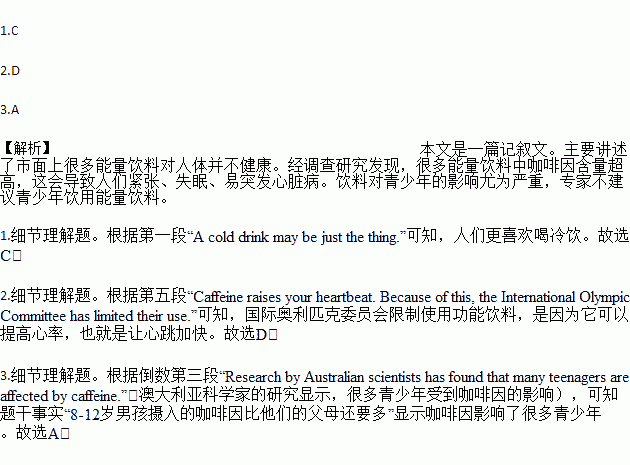题目内容
The weather is getting hotter and you’ll be getting thirstier playing basketball or riding home from school. A cold drink may be just the thing. But be careful what you pour down your throat. Something that looks cool may not be good for your health.
There are plenty of so-called energy drinks on the market. Most of them have an attractive colour and cool name. Their nutrition list also contains various things from vitamins to ginseng. Sounds great!
But after a careful check you may find that most energy drinks contain high levels of caffeine. These drinks are typically aimed at young people, students, busy people and sports players.
Makers sometimes say their drinks make you better at sports and can keep you awake. But be careful not to drink too much.
Caffeine raises your heartbeat. Because of this, the International Olympic Committee has limited their use. The amount of caffeine in most energy drinks is at least as high as in a strong cup of coffee or strong tea.
Research by Australian scientists has found that many teenagers are affected by caffeine. The results of their survey show that 27 percent of boys aged 8-12 take in more caffeine than their parents.
There are potential health risks linked to energy drinks. Just one can of energy drink can make you nervous, have difficulty sleeping and can even cause heart attacks.
Teenagers should be discouraged from consuming drinks with a lot of caffeine in them, an expert from the Australia Nutrition Foundation said.
1.Generally, people would like to ________.
A. take vitamins B. eat ginseng C. have a cold drink D. have a meal
2.The International Olympic Committee limit the use of caffeine because ________.
A. it makes you better at sports B. it can keep you awake
C. it can make you nervous D. it make your heart beat fast
3.The writer mentions the fact that “27 percent of boys aged 8-12 take in more caffeine than their parents” to show that ________.
A. caffeine has an effect on many teenagers
B. parents should take in more caffeine
C. the caffeine problem is not serious
D. the grownups take less caffeine than children
啊
Central Park Outside among the trees, watch the wildlife—both the human and animal varieties. Call(212) 360-3465 or (212) 360-2726 for daily events and tours. Central Park stretches from 59th to 110th Sts., and from 5th Ave. to Central Park West. | |
Empire State Building This is among the most striking buildings in the city, the nation, even the world. The observation deck (瞭望台) on the 86th floor is open to the general public, offering a wonderful view of the city. On the second floor you'll find the New York Skyride, a simulate helicopter ride over Manhattan. 5th Ave. at 34th St., Midtown: (212) 736-3100 | |
Intrepid Sea-Air-Space Museum Five blocks west of Time Square, this museum has hundreds of air, deep-sea and space exhibits. Walk the flight deck of the 900-foot-long aircraft carrier Intrepid, see dozens of old and modern aircraft and ride the Intrepid Navy Flight Simulator. Pier 86, W. 46th St. and 12th Ave.: (212)245-0072 | |
Madison Square Garden If it's big, it probably happens at the Garden. Check out sporting events, concerts and much more. Tours are available. 7th Ave., btwn. 31st and 33rd Sts., Midtown: (212)465-6741 |
1.The New York Skyride is for .
A. sightseeing B. flight training
C. model plane sports D. city transportation
2.If a visitor is interested in music, he will probably go to .
A. Central Park B. Empire State Building
C. Intrepid Sea-Air-Space museum D. Madison Square Garden
3.What is the purpose of these texts?
A. To provide information of living in New York.
B. To provide directions of city traffic in New York.
C. To give visitors a guide to New York.
D. To give a brief introduction to the history of New York.

